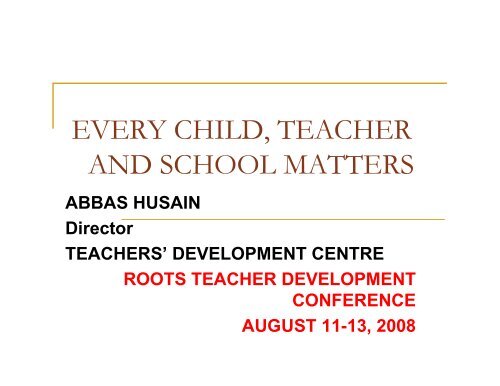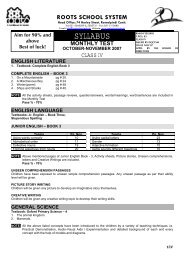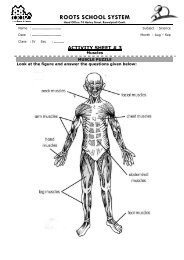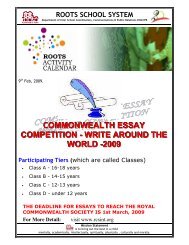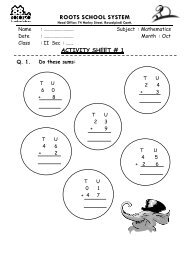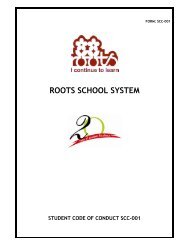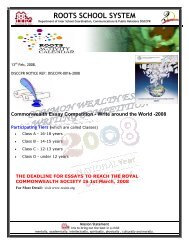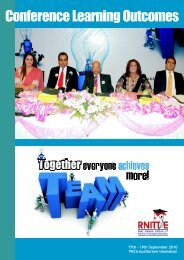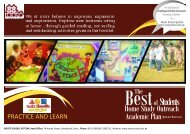every child, teacher and school matters - Roots School System
every child, teacher and school matters - Roots School System
every child, teacher and school matters - Roots School System
- No tags were found...
You also want an ePaper? Increase the reach of your titles
YUMPU automatically turns print PDFs into web optimized ePapers that Google loves.
EVERY CHILD, TEACHERAND SCHOOL MATTERSABBAS HUSAINDirectorTEACHERS’ DEVELOPMENT CENTREROOTS TEACHER DEVELOPMENTCONFERENCEAUGUST 11-13, 2008
WELCOME ☺OVER THE NEXT TWO HOURS WE WILLASK (AND TRY TO ANSWER !) THEFOLLOWING QUESTIONS:1. HOW CAN EVERY CHILD MATTER?2. WHAT CAN EVERY TEACHER DO TOMAKE EVERY CHILD MATTER?3. WHAT KINDS OF SCHOOLS MUSTTHERE BE TO ALLOW EVERY TEACHERTO DO WHAT IS NEEDED TO MAKEEVERY CHILD MATTER?
HMMM… QUITE A LOT THERE!BUT YOU WILL INSTANTLY SEE THATTHERE IS A GREAT CONNECTIONBETWEEN ALL THREE…AND WHILE WE MAY HAVE ALWAYSKNOWN IT, IN OUR TIMES IT IS CALLED<strong>System</strong>s Thinking
SO LET US TURN TO THE MASTERSOF WISDOM…THE SUFI MASTERS WHOOFTEN SAID THESHARPEST THINGS IN AWAY THAT GOT THEPOINT ACROSS VERYWELL…
The Tristomachic SurvivalOnce upon a time there were three kinds ofpeople on a certain planet. There were thosewith one stomach, those with two <strong>and</strong> thosewith three stomachs.
At first nobody realized that there was anydifference between them. They lived indifferent areas, <strong>and</strong> adopted the food <strong>and</strong>habits which corresponded best with theirstomachic peculiarities.
But as they multiplied theirdifferences became <strong>matters</strong>of contention.Sometimes themonostomachics prevailed,sometimes the bistomachics,sometimes the tristomachics.
Then with realism <strong>and</strong> through adesire for equity, they decided toabolish all differences based onstomachs. The result was thatpeople, happily enough, eventuallyforgot that there were any of theseanatomical differences.
They now had a unified culture,which was completely blind tothis detail. Even thetechnological instrumentsdevised by the people did notregister stomach differences.
And then, a new element crept in.As food supplies increased inquantity <strong>and</strong> decreased in quality(for unforeseen reasons) themonostomachics <strong>and</strong> bistomachicscould not endure the new diet <strong>and</strong>began to die out.
Because the ancient taboo againstknowing anything about stomachs hadbeen established even in the geneticinheritance of the people, nobody couldsolve the problem, <strong>and</strong> only thetristomachics survived.--- Idries Shah, 1972: THE MAGIC MONASTERYE.P. Dutton & Co., Inc., New York
THAT IS A MARVELLOUS STORY…I WANT YOU TO THINK ABOUT IT FOR AMINUTE… IN SILENCE… AND JOT DOWNONE OR TWO KEY WORDS OR IDEAS…THAT SEEM TO YOU TO BE THE MOSTIMPORTANT ISSUE IN THE STORY…OK?...SILENCE, PLEASE…. THINK….
OK WE’LL TALK ABOUT THATLATER…LET US MOVE ON….HOW CAN EVERY CHILD MATTER?YOU SEE THAT THE QUESTION IS how can<strong>every</strong> <strong>child</strong> matter to a <strong>teacher</strong>?
WE ARE OBVIOUSLY TAKING AMORAL ISSUE HEREAND WITH THAT WE COME UPON A SET OFIDEAS THAT I HAVE USED IN ALL MYWORK OF TEACHER TRAINING, ANDSTAFF DEVELOPMENT IN SCHOOLS…TITLED IT MEANINGINVITATIONAL THINKING
WILLIAM PURKEYHAS DESCRIBED THE TEACHING AS ANINVITATIONTO A LIFE OF HUMANITY, SANITY ANDNOBILITY…SURELY, WE AS TEACHERS MUST ACCEPTTHAT OUR WORK IS TO INVITE THESTUDENTS…
INVITATIONAL THINKINGOFFERS US A SET OF TOOLS TO THINKABOUT OUR WORK, AND SO WHEN ITAKE THE ISSUE OF EVERY CHILDMATTERS,THIS IS THE FIRST DIMENSION:AM I OFFERING A CURRICULUM THAT ISINVITING?
THE CURRICULUMARE THERE PARTS OF IT THAT AREDISINVITING?IF SO, WHAT CAN I DO AS A TEACHER TOREACH THE CHILD WITH THATMATERIAL?
LET US STEP BACK A LITTLETHERE ARE SOME ISSUES THAT EVERYTEACHER MUST ADDRESS AS APROFESSIONAL AND AS A PERSON…I USUALLY PUT THIS IN THE FORMAT OFTHREE QUESTIONS…AND IT IS HERETHAT EVERY CHILD MATTERS. PLEASETAKE A MOMENT TO JOT DOWN YOURANSWER
LET ME REPHRASE THAT…IN THE NEXT SEQUENCE OF SLIDES YOUARE GOING TO SEE SOME QUESTIONS.I WANT YOU TO TAKE A MOMENT TOWRITE WHAT YOU THINK THE QUESTIONMEANSAND THEN TO WRITE A FEW KEY WORDSOF AN ANSWER… OK… GOT THAT?
THREE QUESTIONS EVERYTEACHER MUST ANSWERThe first of these concerns the form of therelationship with the <strong>child</strong>:What balance do I strike betweenexpertise <strong>and</strong> nurturance?
THREE QUESTIONS EVERYTEACHER MUST ANSWERThe second concerns the <strong>teacher</strong>’srelationship with colleagues <strong>and</strong> parents inthe <strong>school</strong> community:What is my responsibility for shaping theculture of the <strong>school</strong>?
THREE QUESTIONS EVERYTEACHER MUST ANSWERThe answer to the third question determinesthe <strong>teacher</strong>’s relationship with the society:Am I primarily a transmitter ora transformerof my society’s values?
OK ….LET US DISCUSS THAT A LITTLE…I WILL ASK ONLY FIVE PEOPLE…TO TELL ME WHAT DO THEY THINK THEQUESTION MEANS…NOT THEIR ANSWER
Every <strong>child</strong> <strong>matters</strong>…BUT WE MUST FINISH THE CURRICULUM!BUT WE MUST GET THE GRADES!!BUT WE MUST FINISH THE EXERCISES!!!Sounds familiar?
It seems that we must constantlyremind ourselves…PARKER PALMER has written thatthree questions make us sit up <strong>and</strong>take noticeWHO DO I TEACH?WHAT DO I TEACH?WHO IS IT THAT TEACHES?
WHICH ALLOWS ME TO COME TOTHE NEXT QUESTION FOR TODAYWHAT CAN EVERY TEACHERDO TO MAKE EVERY CHILDMATTER?
A VERY IMPORTANT THEMETHE PROFESSIONALISMANDPROFESSIONALITYOF TEACHERS…TWO WORDS THAT ARE OFTENCONFUSED AND WE MUST CLARIFY…
THE WORK OF LINDA EVANSIS OF PIONEERING VALUE ON THESUBJECT…AND THE FOLLOWING CHARTS WILLALLOW US TO MAKE THE DISTINCTIONWITH CLARITY…Source:Hoyle, E. (1974) ‘Professionality,professionalism <strong>and</strong> control in teaching’. LondonEducational Review,3 (2), Summer 1974, pp.13-19
• Professionalism – strategies <strong>and</strong> rhetoricsemployed by members of an occupation toimprove status, salary <strong>and</strong> conditions.• Professionality – knowledge, skills <strong>and</strong>procedures employed by <strong>teacher</strong>s in theprocess of teaching.
• Hoyle (1974) illustrates the range ofprofessionality typically manifested by<strong>teacher</strong>s by describing two extremes:• Restricted professional• Extended professional
Restricted ProfessionalityExtended ProfessionalitySkills derived fromexperiencePerspective limited to theimmediate in time <strong>and</strong> placeWorkplace events perceivedin isolationIntrospective with regard tomethodsSkills derived from amediation betweenexperience <strong>and</strong> theoryPerspective embracing thebroader social context ofeducationWorkplace events perceivedin relation to policies <strong>and</strong>goalsMethods compared withthose of colleagues <strong>and</strong> withreports of practice
Restricted ProfessionalityExtended ProfessionalityValue placed onautonomyLimited involvement innon immediateprofessional activitiesValue placed onprofessionalcollaborationHigh involvement innon immediateprofessional activities(eg networks,research, professionalassociations)
Infrequent reading ofprofessionalliteratureRegular reading ofprofessionalliteratureInvolvement inprofessionaldevelopment limited<strong>and</strong> confined topractical coursesWork seen as anintuitive activityInvolvement inprofessionaldevelopmentconsiderable <strong>and</strong>includes learning oftheoretical natureWork seen as arational activity
SO MUCH FOR THOSE OF USWHO WOULD LIKE TO KNOW WHAT TO DO TOBECOME PROFESSIONALS…BUT TAKING INSPIRATION FROM A CLASSICBOOK OF OUR TIMES ON MANAGEMENTJIM COLLINS’ FROM GOOD TO GREATI THOUGHT A LIST OF 14 CHARACTERISTICS OFGREAT TEACHERS WOULD ALSO BEHELPFUL.
HERE THEN…BUT BEFORE I GO ON PLEASE NOTETHE NUMBER(S) WHICH RELATE TO• THE TEACHER AS A PERSON• THE TEACHER IN THE CLASSROOM• TESTING AND• THE TEACHER IN THE STAFFROOMTHERE MIGHT BE SOME OVERLAP ☺
1. Great <strong>teacher</strong>s never forget that it ispeople, not programs, that determinethe quality of a <strong>school</strong>.2. Great <strong>teacher</strong>s establish clearexpectations at the start of the year<strong>and</strong> follow them consistently as theyear progresses.3. When a student misbehaves, great<strong>teacher</strong>s have one goal: to keep thatbehavior from happening again.
4. Great <strong>teacher</strong>s have highexpectations for studentsbut even higherexpectations for themselves.
5. Great <strong>teacher</strong>s know who is thevariable in the classroom: Theyare.Good <strong>teacher</strong>s consistently striveto improve, <strong>and</strong> they focus onsomething they can control-theirown performance.
6. Great <strong>teacher</strong>s create a positiveatmosphere in their classrooms <strong>and</strong><strong>school</strong>s.They treat <strong>every</strong> person with respect.In particular, they underst<strong>and</strong> thepower of praise.
7. Great <strong>teacher</strong>s consistently filter out thenegatives that don't matter <strong>and</strong> share apositive attitude.8. Great <strong>teacher</strong>s work hard tokeep their relationships in goodrepair--to avoid personal hurt<strong>and</strong> to repair any possibledamage.
9. Great <strong>teacher</strong>s have the abilityto ignore trivial disturbances;to respond to inappropriatebehavior without escalating thesituation.
10. Great <strong>teacher</strong>s have a plan <strong>and</strong>purpose for <strong>every</strong>thing they do.If things don't work out the waythey had envisioned, they reflecton what they could have donedifferently <strong>and</strong> adjust their plansaccordingly.
11. Before making anydecision or attempting tobring about any change,great <strong>teacher</strong>s askthemselves one centralquestion: What will the bestpeople think?
12. Great <strong>teacher</strong>s continually askthemselves who is mostcomfortable <strong>and</strong> who is leastcomfortable with each decision theymake. They treat <strong>every</strong>one as ifthey were good.
13. Great <strong>teacher</strong>s keepst<strong>and</strong>ardized testing inperspective; theycenter on the real issueof student learning.
14. Great <strong>teacher</strong>s care abouttheir students. Theyunderst<strong>and</strong> that behaviors<strong>and</strong> beliefs are tied toemotion, <strong>and</strong> they underst<strong>and</strong>the power of emotion to jumpstartchange.
But how do they do all this?I NOW TURN TO THE LAST PART OF MYPRESENTATIONFIRST OF ALL LET US SEE HOW WE GOTHERE…HOW DID WE BECOME THE TEACHERSTHAT WE DID?
THAT IS A MIGHTY COMPLEXCHART…AND IT ALLOWS US TO LEARN SOMETHINGABOUT OURSELVES…REMEMBER THAT IF WE HAVE DONEGRADUATION OR MORE, WE HAVEEASILY SPENT MORE THAN 15,000 DAYSOF OUR LIVES IN CLASSROOMS !SURELY THAT WILL SHAPE OUR THINKINGSOMEWHAT?
FACTORS THAT INFLUENCE HOW WE TEACHGenderAgeExperiencePersonalityBeliefsPersonal PersonalCharacteristicsCharacteristicsHow we were taughtHow we prefer to be taughtHow we prefer to teachOur subject matterbackgroundOur teaching preparationExperience<strong>and</strong> <strong>and</strong>Preparation in inEducationHowweTeachNature of the learnersClass/classroom sizeMaterials, equipmentTimeNature of the lessonNational imperativesContext of ofTeaching
HAVING SAID THAT,I WOULD LIKE TO SPELL OUT SOMEPERSONAL IMPERATIVES, THAT I HAVELIVED BY IN ALL MY WORK.THIS IS A PERSONAL LIST, FROM MY OWNEXPERIENCE. WHILE READING HASHELPED, IT HAS BEEN A SOURCE OFREINFORCEMENT ONLY…
I BELIEVE THAT EVERY CHILD HAS ARIGHT TO A DIGNIFIED TREATMENT ATEACH MOMENT OF SCHOOLI BELIEVE THAT EACH TIME WE RAISE OURVOICES, WE ARE PERMITTING THECHILDREN TO DO SO TOO.
I BELIEVE THAT THE YOUTH OF TODAY ISIMMENSELY TALENTED AND NEEDSONLY A LITTLE SUPPORT ANDENCOURAGEMENT TO BE ON HIS/HERWAYMY STUDENTS WILL GO TO PLACES I WILLNEVER GO, REACH HEIGHTS I WILLNEVER REACH. LET ME HELP THEM GETSTARTED.
THE CHILDREN OF TODAY NEED SKILLSWE DID NOT NEED. FOR EXAMPLE THEYWILL NEED TO PROCESS VASTAMOUNTS OF INFORMATION.THEY WILL NEED TO BECOME GLOBALCITIZENS, CONNECTED GLOBALLY…FROM KINDERGARTEN.
WE NEED TO RECOGNISE THAT THEWORLD IS CHANGING FASTER THAN WECAN COPE…BUT SOME HUMAN REALITIES DO NOT…SO LET US MAKE SURE THAT WETRANSFER THE VALUES AND NOT LOSETHEM IN THE OTHER PERISHABLESTUFF
• AND SO WE COME TO THE END OFTODAY…AND WE RETURN TO THEQUESTION ABOUT THE TRISTOMACHICS• REMEMBER? THE SUFI STORY WEBEGAN WITH…?YES, PLEASE TELL ME… WHAT DID YOUTHINK IT MEANT?ONLY 20 ANSWERS PLEASE….
ONE FINAL REFLECTIONTEACHING STOPS BEFORE WE ENTER THECLASS…LEARNING BEGINS AFTER WE ENTER THECLASS.LET US MAKE THIS TRUE FROM TODAY
QUESTIONS?
THANK YOU
FOR A SOFT COPY OFTHIS PRESENTATIONSEND AN EMAIL TOabbas@tdc.edu.pk
ABBAS HUSAINDIRECTORTEACHERS DEVELOPMENT CENTRE129G BLOCK 2 PECHS KARACHI 75400PHONE: 4310217/4392949www.tdc.edu.pk


